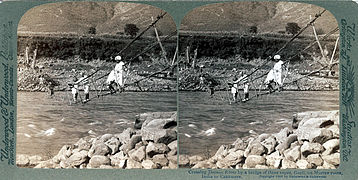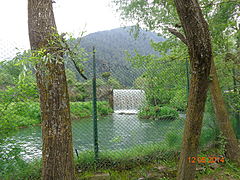The Jhelum River is a river in the northern Indian subcontinent. It originates at Verinag and flows through the Indian administered territory of Jammu and Kashmir, to the Pakistani-administered territory of Azad Kashmir, and then into the Pakistani province of Punjab. It is the westernmost of the five rivers of the Punjab region, and flows through the Kashmir Valley. It is a tributary of the Chenab River and has a total length of about 725 kilometres (450 mi).
Etymology

Verinag Spring is a major source of Jhelum River
Anjum Sultan Shahbaz, a Pakistani author, recorded some stories of the name Jhelum in his book Tareekh-e-Jhelum as:
Many writers have different opinions about the name of Jhelum. One suggestion is that in ancient days Jhelumabad was known as Jalham. The word Jhelum is reportedly derived from the words Jal (pure water) and Ham (snow). The name thus refers to the waters of a river (flowing beside the city) which have their origins in the snow-capped Himalayas.
However, some writers believe that when Mughal prince Dara-e-Azam reached a certain place on the river bank after winning many battles, he fixed his flag at that place and called it Ja-e-Alam (Persian: جا علم, lit. ‘Place of the Flag’). As time passed, the name Ja-e-Alam became Jhelum in its modern form.
The Sanskrit name of this river is Vitástā. The river’s name is derived from an apocryphal legend regarding the origin of the river as explained in the Nilamata Purana. Hindu goddess Parvati was requested by the sage Kasyapa to come to Kashmir for purification of the land from evil practices and impurities of Pisachas living there. Goddess Parvati then assumed the form of a river in the Nether World. Then Lord Shiva made a stroke with his spear near the abode of Nila (Verinag Spring). By that stroke of the spear, Goddess Parvati came out of the Nether World. Shiva himself named her as Vitasta. He had excavated with the spear a ditch measuring one Vitasti (a particular measure of length defined either as a long span between the extended thumb and little finger, or as the distance between the wrist and the tip of the fingers, and said to be about 9 inches), through which the river – gone to the Nether World – had come out, so she was given the name Vitástā by him. The name survives in the Kashmiri name for this river, Vyath.
History

A passenger traversing the river precariously seated in a small suspended cradle Circa 1900
The river Jhelum is called Hydaspes (Greek: Υδάσπης) by the ancient Greeks. According to the major religious work Srimad Bhagavatam, the Vitastā is one of the many transcendental rivers flowing through land of Bharata, or ancient India.
Alexander the Great and his army crossed the Jhelum in BC 326 at the Battle of the Hydaspes River, where he defeated an Indian king, Porus. According to Arrian (Anabasis, 29), he built a city “on the spot whence he started to cross the river Hydaspes”, which he named Bukephala (or Bucephala) to honour his famous horse Bukephalus or Bucephalus which was buried in Jalalpur Sharif. It is thought that ancient Bukephala was near the site of modern Jhelum City. According to a historian of Gujrat district, Mansoor Behzad Butt, Bukephalus was buried in Jalalpur Sharif, but the people of Mandi Bahauddin, a district close to Jehlum, believed that their tehsil Phalia was named after Alexander’s dead horse, saying that the name Phalia was a distortion of Bucephala. The waters of the Jhelum are allocated to Pakistan under the terms of the Indus Waters Treaty. India is working on a hydropower project on a tributary of Jhelum river to establish first-use rights on the river water over Pakistan as per the Indus Waters Treaty.
Mythology
The river was regarded as a god by the ancient Greeks, as were most mountains and streams; the poet Nonnus in the Dionysiaca (section 26, line 350) makes the Hydaspes a titan-descended god, the son of the sea-god Thaumas and the cloud-goddess Elektra. He was the brother of Iris, the goddess of the rainbow, and half-brother to the Harpies, the snatching winds. Since the river is in a country foreign to the ancient Greeks, it is not clear whether they named the river after the god, or whether the god Hydaspes was named after the river.
Course
The river Jhelum rises from Verinag Spring situated at the foot of the Pir Panjal in the southeastern part of the Kashmir Valley administered by India. It is joined by its tributaries Lidder River near village Mirgund at Khanabal, Veshaw River at Sangam in Anantnag, Sind River at Shadipora and Pohru River at Doabgah in Sopore in Jammu and Kashmir. It flows through Srinagar and Wular Lake before entering Pakistan-administred Kashmir through a deep narrow gorge. The Neelum River, the largest tributary of the Jhelum, joins it at Domel Muzaffarabad, as does the next largest, the Kunhar River of Kaghan Valley. It is then joined by the Poonch River, and flows into the Mangla Dam reservoir in the Mirpur District. The Jhelum enters Pakistani Punjab in the Jhelum District. From there, it flows through the plains of Pakistan’s Punjab, forming the boundary between the Jech and Sindh Sagar Doabs. It ends in a confluence with the Chenab River at Trimmu in the Jhang District. The Chenab merges with the Sutlej to form the Panjnad River, which joins the Indus River at Mithankot.
Most of the villages and important cities in Kashmir valley are situated on the banks of Jhelum.
Lakes
- Wular Lake
- Dal Lake
- Manasbal Lake
- Gangabal Lake
- Nigeen Lake
- Anchar Lake
- Khanpursar
- Gil Sar
Dams and barrages
The river has rich power generation potential in India. Water control structures are being built as a result of the Indus Basin Project, including the following:
- Mangla Dam, completed in 1967, is one of the largest earth-fill dams in the world, with a storage capacity of 5,900,000 acre-feet (7.3 km3)
- Rasul Barrage, constructed in 1967, has a maximum flow of 850,000 ft³/s (24,000 m³/s).
- Trimmu Barrage, constructed in 1939 some 20 km from Jhang Sadar at the confluence with the Chenab, has maximum discharge capacity of 645,000 ft³/s (18,000 m³/s).
- Haranpur (Victoria Bridge) Constructed in 1933 Approximate 5 km from Malakwal near Chak Nizam Village. Its length is 1 km mainly used by Pakistan Railways but there is a passage for light vehicles, motorcycles, cycles and pedestrians at one side.
- Uri Dam with 480 MW Hydroelectric station is located in Baramulla district of Jammu and Kashmir.
- Uri Dam II with 240 MW HYdro elctric station is also located in Baramulla district of Jammu and Kashmir.
- Kishanganga Hydroelectric Plant with 330 MW Hydroelectric station is located in Bandipora district of Jammu and Kashmir.
Canals
- The Canals in and around the city of Srinagar.
- The Upper Jhelum Canal runs from Mangla Dam to the Chenab.
- The Rasul-Qadirabad Link Canal runs from the Rasul Barrage to the Chenab.
- The Chashma-Jhelum Link Canal runs from the Chashma Barrage on the Indus River to the Jhelum river downstream of Rasul Barrage. This is 40 kilometres (25 mi) from Mari Shah Sakhira town.
Gallery
-

Jhelum river, Baramullah, Kashmir, 1880s
-

Jhelum River c. 1900; photo taken by Eugene Whitehead Esq.
-

Jhelum River at Uri in Kashmir, 1903
-

Rope Bridge at Karli, 1908
-

Bridge over the river, Srinagar, 1969
-

Jhelum river near Muzaffarabad (2014)
-

File:River Jehlum, Muzaffarabad
-

Near Muzaffarabad, 2014
-
The Jhelum at Verinag, 2014
-
Jhelum River at Jhelum City, 2005


